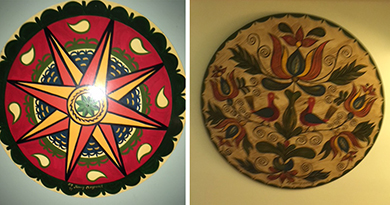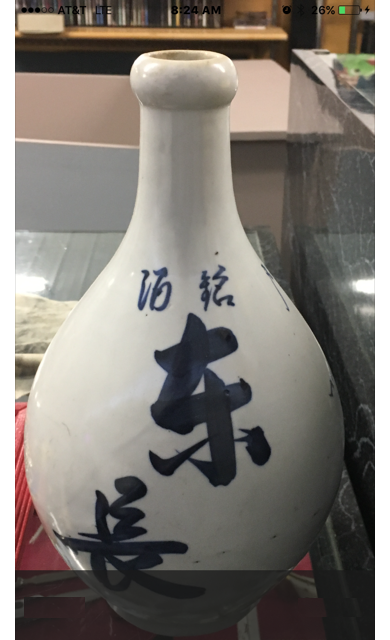 |
|
|||
 |
 |
|||
RINKER ON COLLECTIBLES — Column #1627 Copyright © Harry Rinker, LLC 2018 Questions
and Answers
QUESTION: I recently acquired two hex signs painted by Johnny Claypoole. The Tree of Life measures 24-inches in diameter and was painted in 1979. The Sun and Rain, fertility symbols, is 18-inches in diameter and was painted in 1977. I am just wondering if they ae worth anything? I do not really care because I like them. DA, Robesonia, PA, Email Ques 
ANSWER: Having grown up in Pennsylvania German country, I am very familiar with barn stars, the geometric symbols painted on bank barns to keep away the evil spirits. The early Pennsylvania German settlers saw mysticism and spiritualism as equal partners in governing life’s path. The earliest barn stars date back to the beginning of the 19th century. The exact meaning of the barn stars still is being debated. The hex sign arrived on the scene as part of the 1940s folk art revival. Wallace Nutting coined the word in 1932 when he called them “hexafoss,” meaning “witches foot.” Hex signs are a commercial product designed to allow individuals to take home a conversational souvenir from Pennsylvania German county. Johnny Ott, known as the Professor of Hexology, was one of the many artists responsible for the numerous contemporary hex signs sold along the highways, in stores, and at folk festivals in eastern Pennsylvania. To enhance the symbolism of the hex signs’ birds, butterflies, hearts, geometric patterns, rosettes, and tulips, Ott concocted an elaborate mythology associated with each design. His successors followed his lead. In the mid-1960s, Johnny Claypoole, a foundry worker in his mid-40s, was a student of Johnny Ott, who held sway at the Lenhartsville Hotel on Pennsylvania’s old Route 22. Designated by Ott as his successor, Claypoole quit his job and began painting hex signs full time. His fame quickly spread. He was featured twice in “On the Road with Charles Kuralt” and appeared on “To Tell the Truth.” Claypoole, a renowned storyteller, spread the gospel that hex signs not only warded off ghosts and other evil spirits but brought good luck as well. He was a folk character in his own right, usually dressed in a black Amish hat and a blue denim work shirt and overalls that complemented his Lincoln-type beard and plump figure. He traveled the craft show circuit in his Volkswagen bus. Claypoole practiced his craft for 30 years, dying on August 18, 2004 in the Lehigh Valley (PA) Hospital. His son Eric Claypoole and granddaughter Meaghan Claypool continue his work. Johnny Claypoole’s hex signs have a modest secondary market value, especially among Pennsylvania German and mystical collectors. Your signs were painted when Johnny Claypoole was at the height of his career. They are not one-of-a-kind. Although Claypoole did some special commissions, his work was commercial and repetitive. He focused on designs that were well received and had a strong lore associated with them. Based on recent sell through examples I found on WorthPoint.com, your larger sign with its elaborate design is worth between $65.00 and $80.00. Elaborateness of design does impact value. Your smaller fertility sign is worth between $45.00 and $60.00. Be careful where you hang it. 
QUESTION: My wife likes to cook. We keep looking for some high-quality, stainless steel cookware. Is there a collectible stainless steel cookware that we could purchase that would last for a long time and not cost over $100.00 a pot? – JP, State College, PA, Email Question ANSWER: A 1950s LIFETIME stainless steel cookware dinner home party advertisement pictures a sales representative cooking a meal for a hostess and a group of her female friends. The hostess received bonus gifts for every attendee who purchased a set of cookware. Lifetime was only one of a number of cookware manufacturers who sold via the home party system. Today, these cookware hucksters are found at Home and Garden shows and county and state agricultural fairs. Sometime in the 1960s, my mother and her sisters sponsored a cookware dinner home party featuring Cory Flavor Seal cookware, made from 18/8 three-ply stainless steel. Cory was one of many companies that touted “waterless” cookware. I know this because I just went into one of my storage areas and dug out the 7-inch pan from my mother’s set. The good news about the mid-20th century, stainless steel cookware is that it falls into the “too good to throw out” category. As a result, its survival rate is high. If you have no qualms about mixing and matching, start visiting estate sales, local flea markets, and recycling stores such as Goodwill and the Salvation Army. Look for brand names such as Cory, Farberware, Kitchen Kraft, and Lifetime. If your needs are immediate and you have little interest in the hunt, eBay is flooded with pieces. Take time to comparison shop before buying the first example you see. You also might want to checkout the secondary used market for Revere Ware. The pieces have a copper bottom, which some cooks prefer . QUESTION: While in Japan around 1947, my uncle bought two sake jars. When he walked into a sake store, he saw several shelves containing different sizes of “blank” sake bottles. When a customer chose a sake, the clerk bottled it and then painted the name of the sake and the phone number of the shop on the bottle. The writing on the two sake jars is identical but by a different hand. Do my bottles have any value? – KT, Madisonville, KY 
ANSWER: Whether they have any financial value is irrelevant. They have a great backstory. The fact that they are empty probably meant that the sake was good as well. I always am skeptical about “pass it down the generation” stories. My research attempt to determine how sake was sold in Japan in the immediate post-1945 period was only partially successful. I found evidence that there were sake stores, albeit most were associated with a specific manufacturer. Most sake was sold in paper labeled bottles. A Google search of “vintage late 1940s hand painted sake bottles” resulted in more than a dozen images. Most bottles had a tall, tapered conical body. I did not find any bulbous body bottles. Not finding evidence for something does not mean it did or does not exist. I am certain your sake bottles are period. I just am not looking in the right place. The pictures of late 1940s ceramic sake bottles I found were more elaborately decorated than the examples you own. Your uncle’s story for the limited decoration seems plausible. The secondary market value for your two bottles is between $15.00 and $20.00 each. REQUEST FOR HELP – Did any readers who served in the US military or lived in Japan in the late 1940s or 1950s have s similar experience? If yes, email your recollections to harrylrinker@aol.com QUESTION: I have a life-size picture of Raquel Welch. I found it rolled up in a tube in the attic of a house that I bought. I paid $350.00 to have it framed because I loved it so much. How much is it worth? – VM, Email Question 
ANSWER: Love makes people do strange things. To each his/her own. The Raquel Welch poster sells through on eBay and auction sites for $40.00 to $55.00, shipping included. Patience often results in the ability to buy it at a lower price. When valuing any framed item, there are three values that must be considered—the value of the item in the frame, the value of the frame (or framing), and the enhanced value of finished product. The value of the item in the frame is established. You were kind enough to supply the cost of the framing. The only question remaining is what is the value of the finished product? Alas, it is not $400.00 or more. Secondary market value for a framed life-size picture of Rachel Welch is minimal and becoming more minimal by the day. Few males under 40 know who she is. Most women, regardless of age, do not care. At the moment, the secondary market value of your framed Rachel Welch print is around $100.00. Love can be a costly commodity . Harry L. Rinker welcomes questions from readers about
collectibles, those mass-produced items from the twentieth and twenty-first centuries.
Selected letters will be answered in this column.
Harry cannot provide personal answers.
Photos and other material submitted cannot be
returned.
Send your questions to: Rinker on Collectibles, 5955 Mill
Point Court SE, Kentwood, MI 49512.
You also can e-mail your questions to
harrylrinker@aol.com.
Only e-mails containing a full name and mailing address
will be considered.
You can listen
and participate in
WHATCHA GOT?, Harry’s
antiques and collectibles radio call-in show, on Sunday mornings between 8:00 AM
and 10:00 AM Eastern Time.
If you
cannot find it on a station in your area,
WHATCHA GOT?
streams live on the Internet at www.gcnlive.com.
|
||||